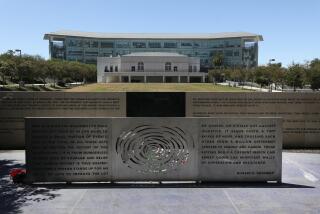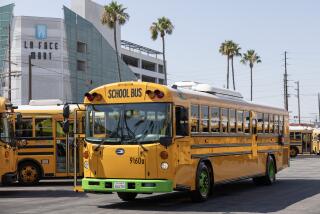Spending Spree Haunting Montebello Schools
The Montebello Unified School District has made its teachers the highest paid in the county, spent millions on expansion and renovation projects, provided a librarian for every school and developed a model fine arts and music program.
In the last two years alone, the district raised salaries and benefits by more than 20%.
The problem is that the district is spending about $17 million more than it expects to receive this year and has earned a place on the state’s list of school districts that are in danger of going bankrupt.
In fact, the Montebello district and the Delano Joint Union High School District in Kern County head the state controller’s list of 32 school districts most likely to finish in the red for the fiscal year that ends June 30.
Montebello Unified will rely on the sale of $7.5 million in bonds to meet its June payroll and avoid becoming the second school district in the state to run out of money this year. Earlier this month, state officials worked out a plan, over Gov. Pete Wilson’s objections, to lend $19 million to the Richmond Unified School District in Northern California.
In addition to Montebello’s bond sale, the school board last month approved $19 million in cuts, which will reduce next year’s budget to about $126 million. On July 1, the district expects to lay off about 200 employees, most of them teachers.
“The bottom line is you can’t spend more than you’re taking in,” said Jay Ziegler, communications director for the state controller. “It is not an overnight phenomenon.”
The district spent about $8.3 million this year for projects such as expanding and renovating district high schools, according to the state. As in other years, the state didn’t reimburse the district as much for these expenses as Montebello educators had hoped. Overall, the district’s operating costs increased more than 20% in the past two years, while district revenues rose only 8%.
In all, the district spent $11.4 million more than it received last year and will overspend its revenues by about $17 million this year, auditors said.
Ziegler said the district may be digging a deeper hole by relying on bond sales to bail itself out. Next month’s sale will bring Montebello’s two-year bond total to more than $20 million. Just arranging the financing burned up $415,000. Next year alone, the district will have to pay more than $3 million to finance the bond rescue, audit manager Mark Steinwert said.
Part of Montebello’s predicament results from funding cuts that have hurt all districts. The district received less lottery money than planned and a lower cost-of-living adjustment from the state. In addition, the district had to set aside $260,000 for a newly imposed property-tax collection fee.
Despite the financial bind, district officials said Montebello’s educational programs will remain comparatively strong, and that the school system will not go under, no matter what the state controller said.
“I think he’s using us politically,” board member Eleanor Chow said. “Gray Davis (the state controller) is way out of line making it look like we’re not responsible.
“We’re not asking the state to bail us out. We’re doing it ourselves. We will take care of our problem if they give us an opportunity to do that.”
Chow, a board member since 1971, conceded that the crisis was real and said that district staff overestimated the district’s state funding more than in other school systems. The district should have started cutting two years ago, she said, “but when you have money and (a reserve), how can you do that?”
District officials have been reluctant to part with special services and programs.
“We had a fully credentialed librarian in every school,” Assistant Supt. Richard Marr said. “We have a tremendous fine arts and music program.”
Such services will take a tremendous hit in next year’s budget. The $19 million in cuts include all the district’s elementary school librarians and 20% of the district’s nurses.
“I’ve seen many budget cuts,” Chow said. “We’re down to the bare bones on this one. I’ve never seen anything like it.”
Most of the employees laid off will be temporary contract teachers who lack tenure protection. More than a third of these teachers are bilingual. About 12,800 of the district’s 33,000 students have a limited ability to speak English, and these students are bound to suffer, officials said.
On Wednesday, teachers wore black armbands in support of colleagues who will lose their jobs. With fewer instructors, the average class size in high school will jump to 42 students, teacher union leaders said.
“It will be hard to see how they can even continue a bilingual program, I would think,” parent Robert Sanchez said. “The program that they had was one of the better ones in the state.”
“I feel that my child’s future is in jeopardy,” parent Deborah Munoz said. “If they do go ahead with the proposed cuts a lot of Hispanic children may not go on to higher education. The kids are even feeling this.”
An early retirement program will allow the district to keep many of its non-tenured bilingual teachers. The district is offering a $25,000 bonus, paid over five years, to veteran teachers who retire. More than 60 teachers have already signed up, board member Chow said.
At last Thursday’s meeting, the board adopted an early retirement plan for non-teaching workers. Long-time employees can choose between a retirement bonus, a larger pension or a health-insurance subsidy after they retire.
Teachers who keep their jobs face a wage cut and loss of benefits. The district’s latest contract proposal for next year includes a 10% pay cut and eliminating health insurance coverage for the spouses and children of employees.
History teacher David Lebow said the district’s problems are a product of good intentions combined with bad management.
“I’ve been in this district 26 years,” Lebow said. “All of these people in upper management are friends of mine. I like these people. By and large they are very good people. They just screwed up.”
Community correspondent Tony Dodero contributed to this article.
The District’s Financial Troubles
The Problem--The district spent $11.4 million more than it received last year and will overspend its revenues by about $17 million this year.
Why It Happened--The district spent about $8.3 million this year for such projects as expanding and renovating district high schools. As in other years, the state didn’t reimburse the district as much for these expenses as educators had hoped. Overall, operating costs increased more than 20% in the past two years; district revenues rose only 8%. And the district received less lottery money than planned and a lower cost-of-living adjustment from the state. In addition, the district had to set aside $260,000 for a newly imposed property-tax collection fee.
What It Will Do--Montebello Unified will rely on the sale of $7.5 million in bonds to meet its June payroll. In addition, the school board last month approved $19 million in cuts, which will reduce next year’s budget to about $126 million. On July 1, the district expects to lay off about 200 employees, most of them teachers.
More to Read
Sign up for Essential California
The most important California stories and recommendations in your inbox every morning.
You may occasionally receive promotional content from the Los Angeles Times.











